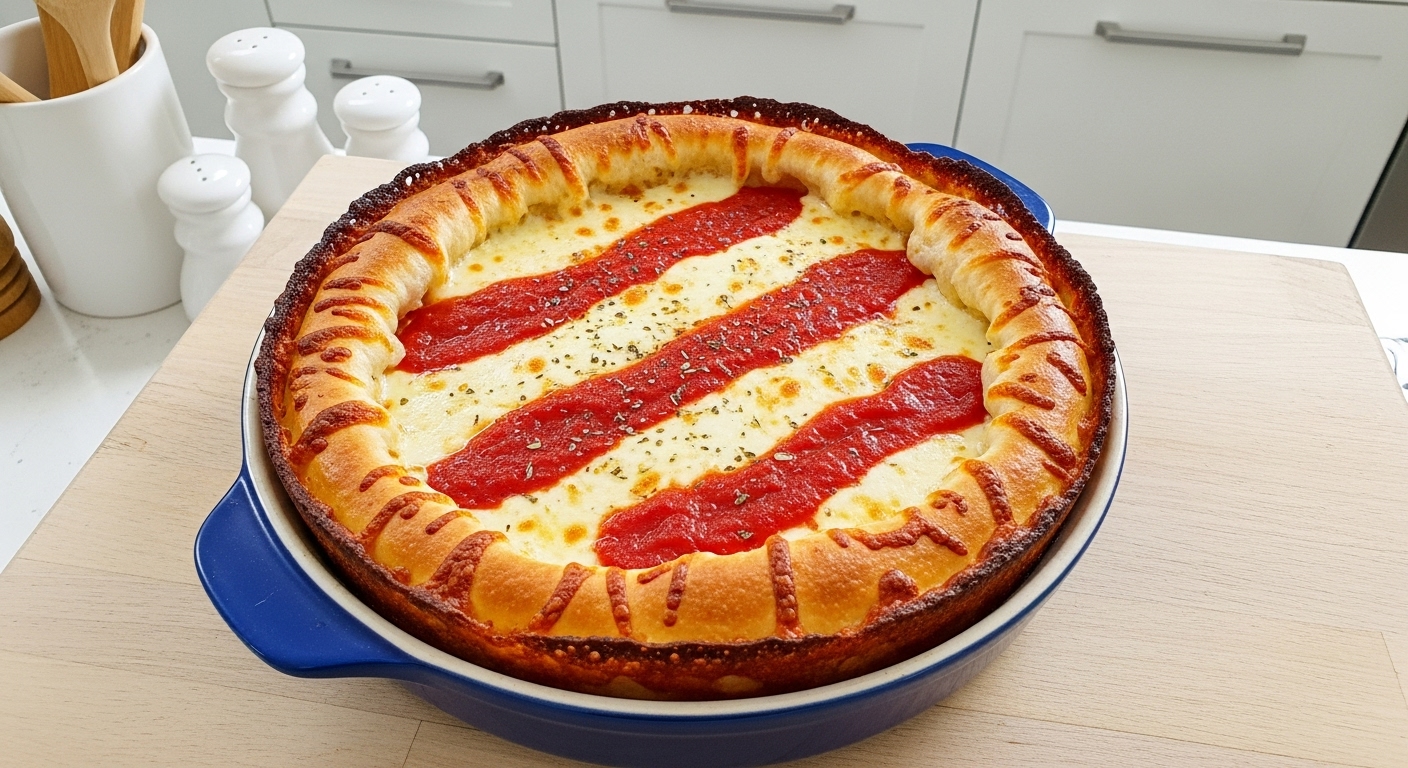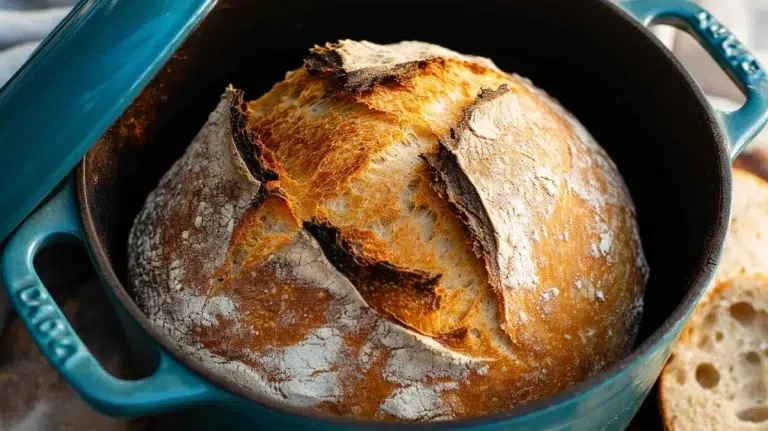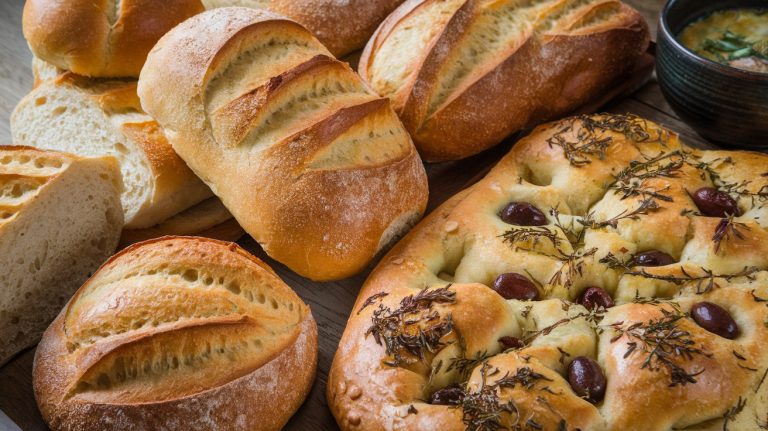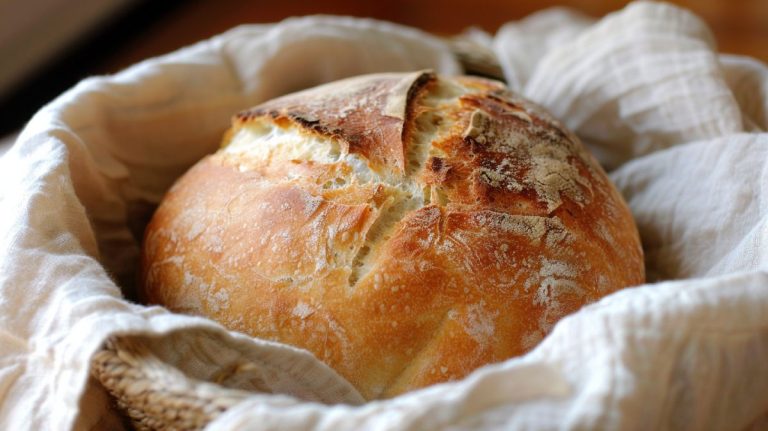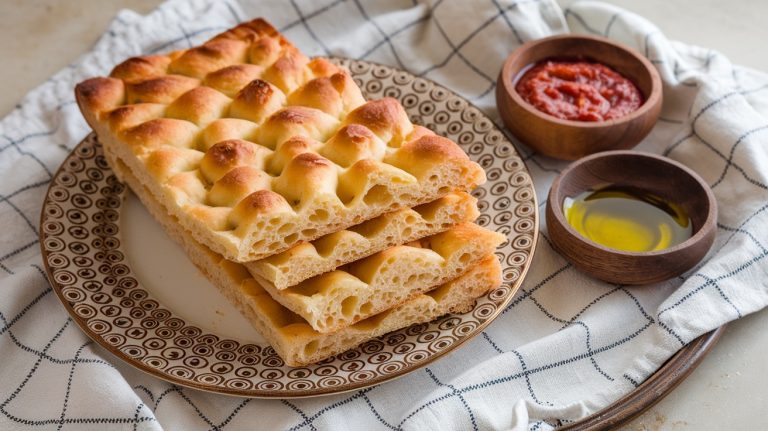Sourdough Detroit Style Pizza Recipe: Thick Crust Perfection
To make sourdough Detroit-style pizza, start with a high-protein flour dough incorporating an active sourdough starter at about 17–20% of flour weight.
After mixing and autolyse, ferment the dough at 74-76°F with stretch-and-folds for 3–4 hours.
Use a well-oiled, medium-sized steel or anodized aluminum pan to stretch the dough to edges without tearing.
Top with a blend of mozzarella and cheddar, add sauce last, then bake at 500°F for 15–17 minutes.
Keep going to master every step for that perfect crispy crust and layered flavor.
Key Takeaways
- Use a high-protein sourdough starter at 17–20% flour weight, autolyse flour and water 20–30 minutes before mixing with starter and salt.
- Stretch dough gently into a well-oiled 10″ x 14″ Detroit-style pan, ensuring even thickness and natural edge cracks for a crispy crust.
- Ferment dough 3–4 hours at 74–76°F with stretch-and-folds every 30 minutes, or cold-proof 24–48 hours for enhanced flavor.
- Oil pan evenly with 2–3 tbsp olive oil before baking to promote a crispy, nonstick crust and re-oil after each use.
- Bake at 500°F for 15–17 minutes on the lowest oven rack, topping with a blend of mozzarella, cheddar, and Wisconsin brick cheese plus sauce last.
Complete Sourdough Detroit Style Pizza Recipe Guide
| Component | Ingredient | Weight/Amount | Baker’s Percentage | Purpose |
|---|---|---|---|---|
| Dough Base | High-protein bread flour | 600g | 100% | Creates strong gluten structure and chewy texture |
| Hydration | Water (room temperature) | 469g | 76-78% | Develops airy crumb and extensible dough |
| Leavening | Active sourdough starter | 114g | 17-20% | Provides natural fermentation and complex flavor |
| Seasoning | Fine sea salt | 16g | 2-3% | Enhances flavor and strengthens gluten |
| Optional | Extra virgin olive oil | 10-15g | 2% | Adds tenderness to crust |
| Fermentation Time | Bulk fermentation | 3-4 hours | 74-76°F | Builds gluten strength through stretch-and-folds |
| Cold Proof | Refrigeration | 24-48 hours | 35-40°F | Deepens sourdough flavor complexity |
| Pan Prep | Olive oil for pan | 2-3 tbsp | – | Creates crispy, fried edges |
| Cheese Layer | Mozzarella & cheddar blend | 225-280g | – | Forms caramelized frico crust |
| Sauce | Tomato sauce | 120-150g | – | Applied last on top of cheese |
| Baking Temp | Oven temperature | 500°F | 15-17 min | Achieves crispy bottom and melted cheese |
| Pan Size | Rectangular pan | 8×10″ to 10×14″ | – | Traditional Detroit dimensions for authentic results |
Essential Ingredients for Sourdough Detroit-Style Pizza

Although Detroit-style sourdough pizza relies on a few key components, getting each ingredient right is essential to achieving its signature texture and flavor.
Start with 100% high-protein bread flour, or blend in some whole wheat for added chew and structure. Maintain a hydration level between 70% and 78% to create a light, airy crumb. Use a mature, active sourdough starter at 17–20% of flour weight for natural leavening. Add fine sea salt at 2–3% of flour weight to enhance flavor and strengthen the dough.
Use 100% high-protein bread flour or mix in whole wheat for extra chew and structure.
You may include olive oil for tenderness, but omitting it yields a firmer crust. For pan preparation, use a rectangular steel pan generously oiled to achieve crispy, fried edges. To decorate your final product creatively, you might consider using cake decorating airbrush kits for professional edible art effects.
Start the sourdough process the day before by mixing flour and water with starter and letting it ferment overnight until doubled in size to develop flavor and structure before baking.
Press the dough directly into the pan without shaping.
Preparing Your Sourdough Starter
When you prepare your sourdough starter, you create the natural leavening that gives Detroit-style pizza its unique texture and flavor.
Begin by mixing equal weights of unbleached all-purpose flour and room-temperature water, around 100g each. For more complexity, blend in whole wheat flour, for example, 75g all-purpose and 25g whole wheat.
Stir thoroughly in a non-metal container, covering it loosely to allow airflow. The mixture should resemble thick batter; adjust flour or water as needed. This starter collects beneficial bacteria and wild yeast from the environment to naturally ferment the dough. Using a sourdough base can also help create a lower glycemic index in the final product.
Feed your starter daily, discarding half before each feeding to control acidity and volume. Add fresh flour and water in equal weights to the remaining starter.
Maintain a warm environment at 70°–75°F and watch for bubbles and volume increase. Your starter is ready when it doubles within 4–6 hours and passes the float test.
Mixing the Dough: Techniques and Tips
When you’re getting ready to mix your sourdough Detroit-style pizza dough, it’s important to aim for a hydration level between 70–78%. This range is key to achieving that soft and extensible texture we all love.
Now, you have a few options for mixing: you can go with machine mixing for a quick and efficient process, or if you prefer a bit more control, hand mixing might be your best bet. There’s also the no-knead method where you can simply stretch and fold the dough during fermentation. Using a high-precision baking scale can help ensure your ingredient measurements are accurate for consistent results.
Oh, and here’s a tip you definitely don’t want to skip—after you combine your ingredients, give the dough a brief rest or autolyse. This little step is super helpful because it improves hydration and gluten development, leading to a much better dough structure in the end.
For a chewy crust that holds up well to toppings, it’s best to use high-protein bread flour, such as King Arthur Baking Bread Flour, which supports the dough’s structure and texture.
Trust me, it makes a difference!
Ingredient Hydration Ratios
Since hydration levels play a crucial role in the texture and handling of sourdough Detroit-style pizza dough, you need to carefully balance water and flour ratios. Aim for hydration between 70% and 83%. Higher hydration leads to a more extensible dough, which is ideal for the airy crumb typical of Detroit-style pizza.
For example, 469g water to 600g high-protein bread flour at 76% hydration will achieve a tender, chewy crust.
Your sourdough starter should make up about 20% of the flour weight, and fine sea salt roughly 3%. This enhances flavor without hindering fermentation.
Allow the flour to fully absorb water before adding the starter, and maintain consistent temperature for even hydration.
Rest the dough adequately to distribute moisture evenly. Keeping the dough covered and resting for 30 minutes before stretch and folds promotes better gluten development and fermentation control.
Handle the high-hydration dough gently to preserve air pockets.
Use strong bread flour to maintain dough strength and manageability throughout fermentation.
Mixing Methods Explained
Although mixing sourdough Detroit-style pizza dough may seem straightforward, mastering the sequence and timing of combining ingredients is essential for ideal gluten development and hydration.
Start by dissolving your starter in water, then add flour and salt, mixing until no dry bits remain. Use a stand mixer on low speed initially, increasing speed to develop gluten for 5–8 minutes, or hand mix with stretch-and-fold motions for 3–5 minutes until cohesive but soft. Adjustments in hydration can be made by adding small increments of water or flour to achieve the perfect dough consistency.
Immediately rest the dough 10–30 minutes to hydrate flour and begin gluten formation.
Perform multiple stretch-and-fold sets spaced 30 minutes apart to strengthen dough gradually without overworking.
Maintain a soft, pliable consistency; avoid excessive wetness or tightness. Scrape bowl sides frequently to ensure uniform hydration.
Adding olive oil during mixing can improve extensibility and crust texture.
For sourdough Detroit-style pizza, including kosher salt and extra virgin olive oil during initial mixing enhances flavor and dough elasticity.
Resting and Autolyse
Even after mixing, giving your dough time to rest considerably improves its texture and workability.
Start with an autolyse by mixing just flour and water, then let it rest for 20 to 30 minutes. This hydrates the flour and activates enzymes, reducing mixing time and enhancing extensibility. Using a proofing basket after autolyse can help retain dough shape during fermentation.
After autolyse, add your sourdough starter and salt.
Once fully mixed, allow the dough an initial rest of about 10 minutes to relax gluten and hydrate ingredients further.
During bulk fermentation, lasting 7 to 12 hours at room temperature, perform gentle stretch and folds every 30 minutes to build strength without degassing; this technique mimics the stretch and folds used to develop dough strength.
Optionally, cold proofing in the fridge slows fermentation, deepening flavor.
Always handle dough gently, using oiled hands and resting it before shaping to maintain elasticity and ease handling.
Fermentation: Timing and Temperature

When you manage fermentation timing and temperature carefully, you control the dough’s rise, texture, and flavor development.
Aim for bulk fermentation at 74-76°F (23-24°C) for 3 to 4 hours, performing four stretch and folds every 30 minutes to build gluten strength. Using a Danish dough whisk can help mix the dough evenly before fermentation.
If you prefer a longer bulk ferment, raise the temperature slightly to 79-81°F (26-27°C) for up to 7 hours, but monitor closely to avoid overproofing.
After bulk fermentation, cold-proof the dough in the fridge for 24 to 48 hours to slow yeast activity and enhance flavor complexity.
Keep starter feeding timed—6 to 12 hours before mixing—to ensure peak activity.
Remember, warmer environments accelerate fermentation but require careful observation.
Cooler ones slow it, allowing more nuanced flavor and texture development in your sourdough Detroit-style pizza dough.
Choosing and Preparing the Baking Pan
When you’re picking out your baking pan, think about the material. Seasoned steel is great if you want that authentic flavor, while anodized aluminum is super easy to maintain. It’s all about what you prefer! Choosing the right material can also affect heat distribution and cooking efficiency, so consider material types and safety.
Now, don’t forget to oil your pan properly. Using natural oils is a smart move because it not only prevents sticking, but it also helps create that delicious, crispy crust we all love.
And here’s a tip: make sure you choose the right pan size. You want your sourdough dough to fit nicely and bake evenly. So, if you can, go for those standard Detroit dimensions. The medium pan is compatible with most popular Ooni ovens, making it a versatile choice for home baking.
Pan Type Options
How do you choose the best pan for baking an authentic sourdough Detroit-style pizza? Opt for anodized aluminum pans. They’re durable, rust-resistant, and have non-stick coatings like Dura-Kote that eliminate pre-seasoning. These pans also provide excellent heat conduction for even baking.
These dark finishes absorb heat well, ensuring crisp, caramelized cheese edges. Steel pans, especially blue steel, are traditional but require seasoning and maintenance.
Stainless steel with non-stick coatings offers another reliable option, resisting warping and easing cleanup.
Pick a rectangular pan sized between 8×10 and 10×17 inches with angled sides near 75° to form the thick crust and frico edges. Double-thick rims add strength and prevent warping during high-heat baking. Many professional-grade pans are made from 14-gauge anodized aluminum for durability and excellent heat conduction.
Some pans feature perforated bottoms for steam release, influencing crust texture. Consider pan weight and oven compatibility to achieve consistent, authentic results.
Pan Oiling Techniques
Although selecting the right pan is essential, properly oiling it guarantees your sourdough Detroit-style pizza develops that signature crispy crust and caramelized edges.
Start by pouring 2–3 tablespoons of olive or grapeseed oil into the pan, spreading it evenly across the bottom and sides with your fingertips or a paper towel. Using approximately 1.25 lbs of cheese for an 8-9 inch pan balances crust and topping, and adding extra cheese where the dough meets the pan enhances the baked cheese crust. Creating a crispy crust is influenced by the pan’s heat retention and oil distribution.
Avoid excess pooling; only a thin, even coating should remain to prevent stickiness and smoke. Re-oil before each use to maintain the pan’s non-stick surface.
When placing the dough, oil your hands to stretch it gently into the corners without deflating, allowing small gaps.
After baking, wipe the pan clean and lightly re-oil to build seasoning over time, enhancing performance and extending pan life.
Avoid butter or low smoke point oils to prevent burning.
Pan Size Importance
Selecting the right pan size and material directly impacts your sourdough Detroit-style pizza’s texture and cooking performance. Choose between traditional sizes like 8×10 or 10×17 inches, considering your oven’s capacity and desired pizza size.
The pan’s depth (2-3 inches) is vital for that signature thick crust. Aluminum pans are convenient, requiring no seasoning, while steel offers authenticity but needs pre-seasoning. LloydPans offers pans made from 14-gauge, heavy-duty anodized aluminum with a PRE SEASONED TUFF-KOTE finish, eliminating the need for pre-seasoning while enhancing durability and performance.
Using pans with thicker metal construction can help resist warping and ensure even heat distribution during baking. Keep these key points in mind when selecting and preparing your pan:
- Opt for non-stick coatings to ease cleaning and prevent sticking.
- Confirm the pan’s thickness resists warping during baking.
- Pre-season steel pans to avoid rust and improve non-stick qualities.
- Store pans nested to save space and protect their surfaces.
This thoughtful selection guarantees ideal crust texture and consistent baking results.
Dough Shaping and Thickness Considerations
When shaping Detroit-style sourdough pizza dough, you’ll want to stretch it carefully into a square or rectangular form that fits your pan, typically around 10″ x 14″.
Use gentle, even pressure to spread the high-hydration dough without tearing it, allowing small cracks near the edges to form naturally.
Apply gentle, even pressure to stretch the dough, letting natural edge cracks form without tearing.
Aim for a consistent dough thickness across the pan to ensure even baking and a uniform crust.
After shaping, let the dough rest briefly to relax the gluten, helping it maintain shape without springing back. It is beneficial to rest the dough in stages with 20-minute intervals to properly relax gluten.
If using smaller pans, adjust the dough amount accordingly to avoid overly thick or thin crusts.
Proper shaping and thickness control are key to achieving the characteristic light, airy interior and crisp, caramelized edges unique to Detroit-style sourdough pizza.
Selecting and Arranging Toppings
Since the toppings define much of Detroit-style sourdough pizza’s character, you’ll want to choose and arrange them thoughtfully.
Begin with a blend of cheeses, low-moisture mozzarella and cheddar, to achieve a creamy interior and caramelized crisp edges.
Press cheese cubes or shreds evenly to the dough’s edge.
Place pepperoni or vegetables thinly sliced and uniformly layered for balance and texture contrast.
Apply the tomato sauce last in strips or dollops atop the cheese to keep edges crispy. Using a dark quarter sheet pan helps achieve the signature crispy crust by ensuring better heat conduction.
Follow these key steps:
- Use hand-grated cheese for better melting and texture.
- Layer heavier meats beneath or within cheese to control moisture.
- Arrange toppings edge-to-edge to create a caramelized crust.
- Add fresh herbs or delicate greens after baking for vibrancy.
This approach guarantees flavor complexity and the signature Detroit-style texture.
Baking Instructions and Oven Settings
Although proper dough preparation is essential, mastering baking instructions and oven settings is key to achieving the signature crispy crust and perfectly melted cheese of Detroit-style sourdough pizza.
Preheat your oven to 500°F (260°C) for at least 15 minutes, placing the pizza pan on the lowest rack to guarantee even cooking and ideal crust browning. Parbaking the crust at high heat before adding toppings helps develop the characteristic cheese frico crust.
If you use a nonstick pan, lower the temperature to 450°F (232°C) to prevent damage. Coat your pan with olive oil and stretch the dough to the pan’s edges for a well-cooked bottom.
Bake for 15-17 minutes, checking the crust’s sides for desirable browning; extend baking briefly if needed.
For added crispiness, consider using a pizza stone or baking steel to boost thermal mass and heat retention.
Serving Suggestions and Storage Tips
After perfecting your baking technique, focus on how to serve and store your sourdough Detroit-style pizza to preserve its texture and flavor.
Serve it with a blend of mozzarella, cheddar, and Wisconsin brick cheese for richness, topped with pepperoni or prosciutto, and finished with fresh herbs like basil or oregano. For an authentic touch, consider using a thick, crisp Detroit-style crust that enhances both flavor and texture.
Drizzle olive oil or honey to enhance depth. Cut the pizza into square slices to maintain its iconic look.
For storage and reheating, follow these steps:
- Let the pizza cool slightly to prevent cheese from sticking.
- Store leftovers airtight in the fridge for up to 3 days.
- Freeze slices for up to 2 months when needed.
- Reheat in a 350°F oven for 10 minutes to restore crispiness.
This approach keeps your pizza fresh and enjoyable.
Frequently Asked Questions
Can I Use All-Purpose Flour Instead of Bread Flour?
Yes, you can use all-purpose flour instead of bread flour, but expect a lighter, less chewy crust.
You’ll want to increase hydration slightly and maybe extend proofing time to compensate for the lower gluten content.
Adjust your recipe accordingly and consider adding flavor enhancers like herbs.
While all-purpose flour is more forgiving and accessible, bread flour better achieves the thick, chewy texture typical of Detroit-style pizza crusts.
How Do I Adjust Hydration for Humid Climates?
Don’t drown your dough in a swamp; cut your water by 5-10% in humid climates to avoid a sticky mess.
Start by reducing about 25g per 500g flour and adjust based on feel. Use ice-cold water to slow fermentation and keep dough temperature between 15-21°C.
Watch your dough, not the clock, since humidity speeds things up. These tweaks keep your dough manageable and fermentation on point.
What’s the Best Way to Recycle Sourdough Starter Discard?
The best way to recycle sourdough starter discard is to use it in recipes like pancakes, crackers, or focaccia, adding flavor while reducing waste.
You can also dehydrate it into powder for long-term storage or freeze it to extend shelf life.
Composting or using it as chicken feed are eco-friendly options.
Keep some discard in the fridge for future revival, turning it back into active starter with regular feedings when needed.
Can I Freeze the Dough Before Baking?
Yes, you can freeze sourdough pizza dough before baking.
Freeze it after bulk fermentation but before shaping for best results.
Portion the dough, lightly oil it, then wrap tightly in airtight bags or containers to prevent drying.
Thaw in the fridge overnight or at room temperature for a few hours.
Let it rest 1-2 hours at room temperature after thawing before shaping to guarantee good rise and texture.
How Do I Prevent the Cheese From Burning on Top?
To prevent cheese from burning, keep your oven temperature steady and preheat it thoroughly.
Use fresh mozzarella instead of pre-shredded cheese, shredding it just before you start.
Spread the cheese evenly, avoiding thick piles.
Rotate your pizza every few minutes during baking to guarantee even cooking.
Finally, monitor cooking time closely and consider using a pizza stone or screen to distribute heat evenly and protect the cheese from direct, intense heat.
Create Your Sourdough Detroit Pizza Masterpiece
Now that you’ve mastered sourdough Detroit-style pizza, you’re part of a growing trend. Over 60% of home bakers report sourdough recipes improve flavor and texture.
By carefully fermenting your dough and using the right pan, you’ll achieve that signature crispy crust and airy crumb every time. Keep experimenting with toppings and baking times to perfect your pie.
Store leftovers properly to maintain freshness, and enjoy your delicious, artisanal creation again tomorrow.

